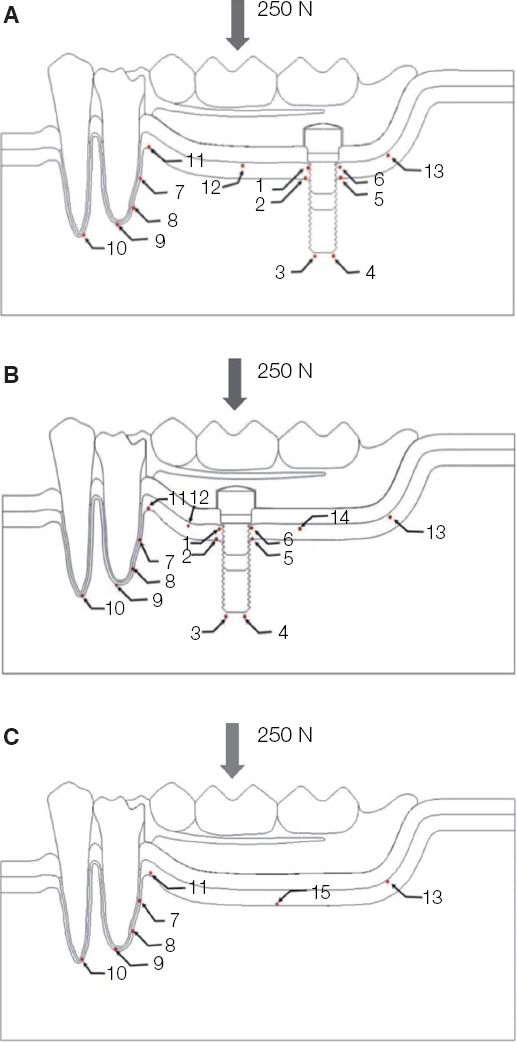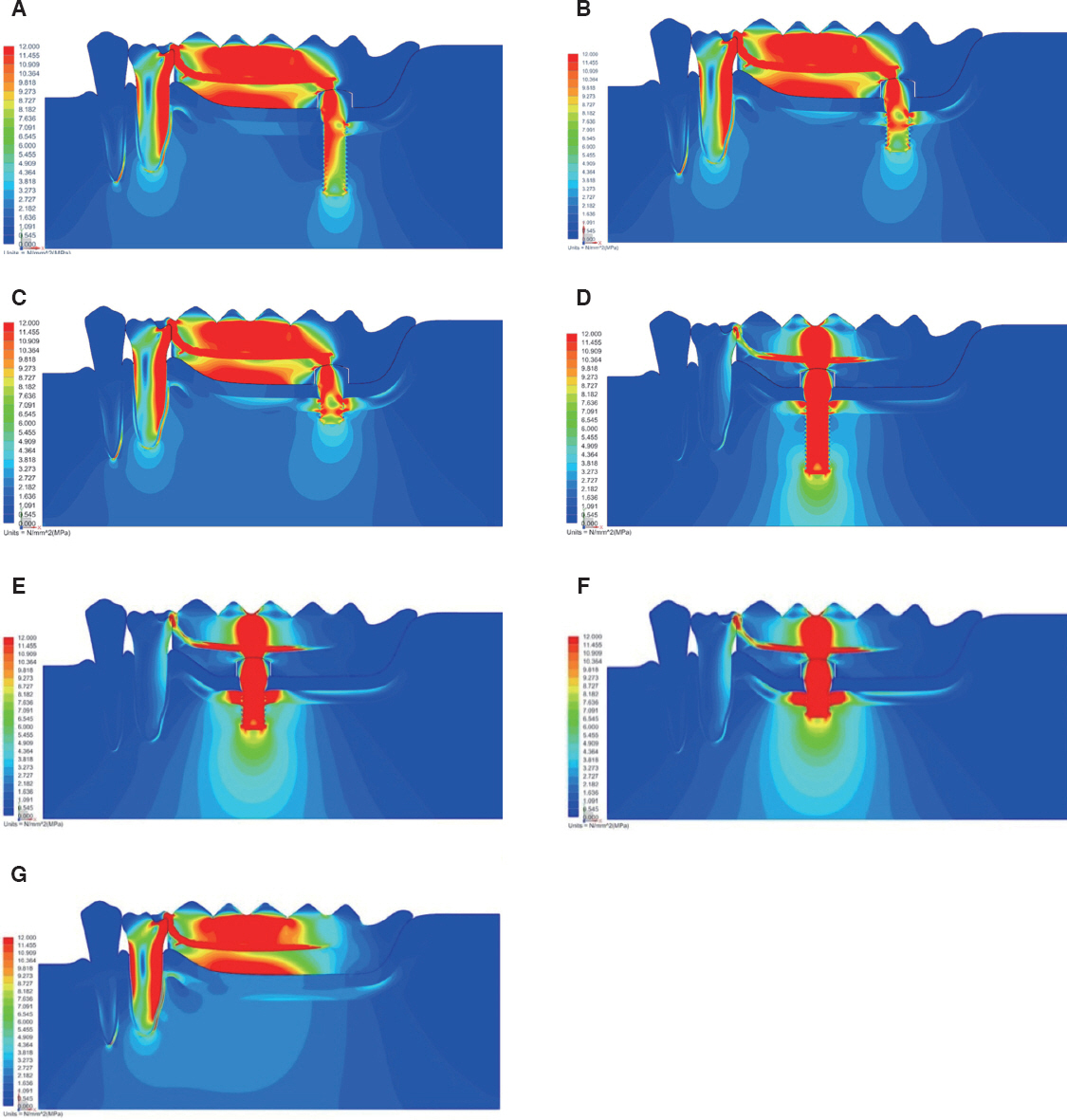J Dent Rehabil Appl Sci.
2015 Sep;31(3):186-194. 10.14368/jdras.2015.31.3.186.
Influence of the length and location of implants on distal extension removable partial dentures: finite element analysis
- Affiliations
-
- 1Department of Prosthodontics, School of Dentistry, Kyungpook National University, Daegu, Republic of Korea. chlee@knu.ac.kr
- KMID: 2180018
- DOI: http://doi.org/10.14368/jdras.2015.31.3.186
Abstract
- PURPOSE
To evaluate the effects of implant location and length on stress distribution and displacement in osseointegrated-implants that were associated with mandibular distal extension removable partial dentures (DERPD).
MATERIALS AND METHODS
A sagittally cut model with the #33, #34 teeth and a removable partial denture of the left mandible was used. Seven models were designed with NX 9.0. Models A, B, C had implants with lengths of 11 ,6, 4 mm, respectively, under the denture base of the #37 artificial tooth. Models D, E, F had implants with lengths of 11, 6, 4 mm, respectively, under the denture base of the #36 artificial tooth. Model G did not have any implants. Axial force (250 N) was loaded on #36 central fossa. The finite element analysis was performed with MSC Nastran. Von Mises stress maps were plotted to visualize the results.
RESULTS
The models of #37 implant placement showed much lower stress concentration on the surrounding bone of the implant compared with #36. The #36 implant position tended to reduce displacement more than #37.
CONCLUSION
When an IARPD is designed, the distal positioning of implant placement has more advantages in the edentulous bone of DERPD on the prognosis of short implants and the stress distribution of edentulous alveolar bone. Using implants with longer lengths are important for stress distribution. However, Additional studies are necessary of the effects of length on implant survival.
Keyword
MeSH Terms
Figure
Reference
-
References
1. Kim SK, Yoo SY, Park IP, Lee JH. Implants in conjunction with removable partial denture. J Korean Dent Assoc. 2011; 49:77–84.2. Kordatzis K, Wright PS, Meijer HJ. Posterior mandibular residual ridge resorption in patients with conventional dentures and implant overdentures. Int J Oral Maxillofac Implants. 2003; 18:447–52. PMID: 12814322.3. Giffin KM. Solving the distal extension removable partial denture base movement dilemma: a clinical report. J Prosthet Dent. 1996; 76:347–9. DOI: 10.1016/S0022-3913(96)90536-3.4. Keltjens HM, Kayser AF, Hertel R, Battistuzzi PG. Distal extension removable partial dentures supported by implants and residual teeth: considerations and case reports. Int J Oral Maxillofac Implants. 1993; 8:208–13. PMID: 8359879.5. Verri FR, Pellizzer EP, Rocha EP, Pereira JA. Influence of length and diameter of implants associated with distal extension removable partial dentures. Implant Dent. 2007; 16:270–80. DOI: 10.1097/ID.0b013e31805007aa. PMID: 17846543.6. Witter DJ, de Haan AF, Käyser AF, van Rossum GM. A 6-year follow-up study of oral function in shortened dental arches. Part I: Occlusal stability. J Oral Rehabil. 1994; 21:113–25. DOI: 10.1111/j.1365-2842.1994.tb01131.x. PMID: 8182494.7. Jorge JH, Quishida CC, Vergani CE, Machado AL, Pavarina AC, Ciampaolo ET. Clinical evaluation of failures in removable partial dentures. J Oral Sci. 2012; 54:337–42. DOI: 10.2334/josnusd.54.337. PMID: 23221159.8. Shahmiri R, Aarts JM, Bennani V, Das R, Swair MV. Strain distribution in a Kennedy class I implant assisted removable partial denture under various loading conditions. Int J Dent. 2013; 2013:351279. DOI: 10.1155/2013/351279. PMID: 23737788. PMCID: PMC3657413.9. Wills DJ, Manderson RD. Biomechanical aspects of the support of partial denture. J Dent. 1977; 5:310–8. DOI: 10.1016/0300-5712(77)90123-3.10. Itoh H, Caputo AA, Wylie R, Berg T. Effects of periodontal support and fixed splinting on load transfer by removable partial dentures. J Prosthet Dent. 1998; 79:465–71. DOI: 10.1016/S0022-3913(98)70163-5.11. Tebrock OC, Rohen RM, Fenster RK, Pelleu GB Jr. The effect of various clasping systems on the mobility of abutment teeth for distal-extension removable partial dentures. J Prosthet Dent. 1979; 41:5116. DOI: 10.1016/0022-3913(79)90082-9.12. Starr NL. The distal extension case: an alternative restorative design for implant prosthetics. Int J Periodontics Restorative Dent. 2001; 21:61–7. PMID: 11829037.13. Monteith BD. Management of loading forces on mandibular distal-extension prostheses. Part I: Evaluation of concepts for design. J Prosthet Dent. 1984; 52:673–81. DOI: 10.1016/S0022-3913(84)80014-1.14. Shahmiri RA, Atieh MA. Mandibular Kennedy class I implant-tooth-borne removable partial denture: a systematic review. J Oral Rehabil. 2010; 37:225–34. DOI: 10.1111/j.1365-2842.2009.02044.x. PMID: 20050984.15. Mijiritsky E, Ormianer Z, Klinger A, Mardinger O. Use of dental implants to improve unfavorable removable partial denture design. Compend Contin Educ Dent. 2005; 26:744–746. 748, 750 passim. PMID: 16231543.16. Pellizzer EP, Verri FR, Falcon-Antenucci RM, Goiato MC, Gennari Filho H. Evaluation of different retention systems on a distal extension removable partial denture associated with an osseointegrated implant. J Craniofac Surg. 2010; 21:727–34. DOI: 10.1097/SCS.0b013e3181d8098a. PMID: 20485037.17. Ohkubo C, Kobayashi M, Suzuki Y, Hosoi T. Effect of implant support on distal-extension removable partial dentures: in vivo assessment. Int J Oral Maxillofac Implants. 2008; 23:1095–101. PMID: 19216279.18. Bortolini S, Natali A, Franchi M, Coggiola A, Consolo U. Implant-retained removable partial dentures: an 8-year retrospective study. J Prosthodont. 2011; 20:168–72. DOI: 10.1111/j.1532-849X.2011.00700.x. PMID: 21438957.19. Grossmann Y, Nissan J, Levin L. Clinical effectiveness of implant-supported removable partial dentures: a review of the literature and retrospective case evaluation. J Oral Maxillofac Surg. 2009; 67:1941–6. DOI: 10.1016/j.joms.2009.04.081. PMID: 19686933.20. Lee JH, Kim DG, Park CJ, Cho LR. A literature review on implant assisted removable partial denture. J Dent Rehabil Appl Sci. 2012; 28:179–90.21. Cunha LD, Pellizzer EP, Verri FR, Pereira JA. Evaluation of the influence of location of osseointegrated implants associated with mandibular removable partial dentures. Implant Dent. 2008; 17:278–87. DOI: 10.1097/ID.0b013e31818363b2. PMID: 18784528.22. Wheeler RC. Dental anatomy, physiology and occlusion. 1974. 5th ed. Philadelphia: WB Saundders Co;p. 185–194. &216-28.23. Pellecchia M, Pellecchia R, Emtiaz S. Distal extension mandibular removable partial denture connected to an anterior fixed implant-supported prosthesis: a clinical report. J Prosthet Dent. 2000; 83:60712. DOI: 10.1016/S0022-3913(00)70057-6. DOI: 10.1067/mpr.2000.107114.24. Chronopoulos V, Sarafianou A, Kourtis S. The use of dental implants in combination with removable partial dentures: a case report. J Esthet Restor Dent. 2008; 20:355–64. discussion 365. DOI: 10.1111/j.1708-8240.2008.00209.x. PMID: 19120779.
- Full Text Links
- Actions
-
Cited
- CITED
-
- Close
- Share
- Similar articles
-
- A THREE DIMENSIONAL FINITE ELEMENT STRESS ANALYSIS ON THE FORCE DISTRIBUTION BY DISTAL EXTENSION PARTIAL DENTURES EMPLOYING ATTACHMENTS
- A STUDY OF THE STRESS DISTRIBUTION OF THE ABUTMENT AND SUPPORTING TISSUES ACCORDING TO THE SLOPES AND TYPES OF GUIDING PLANES OF THE LAST ABUTMENT IN DISTAL EXTENSION REMOVABLE PARTIAL DENTURE USING THREE DIMENSIONAL FINITE ELEMENTANALYSIS METHOD
- Esthetic removable partial denture with implants and resin clasp: Case report
- Rehabilitation of Partial Edentulism with a Crown-type Implant-assisted Removable Partial Denture through Guided Implant Surgery: A Case Report with a 12-month Follow-up
- Stress analysis on the different clasps of the removable partial denture by three-dimensional finite element method



